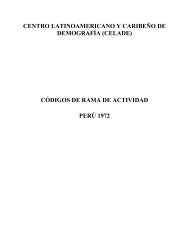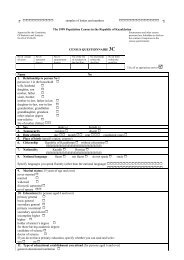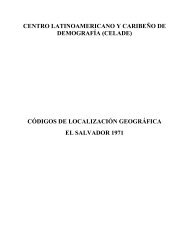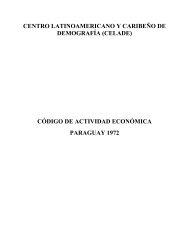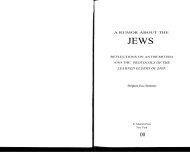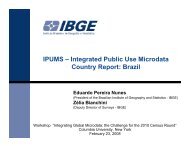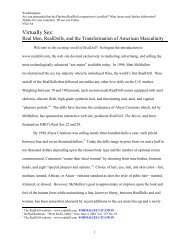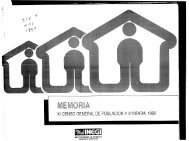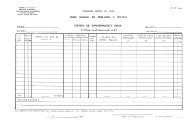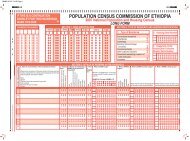The Limitations of Family Reconstitution
The Limitations of Family Reconstitution
The Limitations of Family Reconstitution
You also want an ePaper? Increase the reach of your titles
YUMPU automatically turns print PDFs into web optimized ePapers that Google loves.
<strong>The</strong><br />
<strong>Limitations</strong> <strong>of</strong><br />
<strong>Family</strong><br />
<strong>Reconstitution</strong><br />
Cambridge Group for the History <strong>of</strong> Population and Social Structure<br />
27 Trumpington St.<br />
1
IBM PS/2<br />
P70 386<br />
20 Mhz<br />
640K<br />
memory<br />
21 lbs.<br />
External Storage:<br />
WORM Drive,<br />
200MB Optical<br />
Cartridges<br />
25 lbs. with<br />
transformer<br />
Total weight: 46 lbs<br />
Total cost: $9,500<br />
Jim Oeppen<br />
Me<br />
2
Mother<br />
Born: 1550<br />
Dies: 1617<br />
Marries: 1575<br />
Children Born: 4<br />
Father<br />
Born: 1544<br />
Dies: 1610<br />
Marries: 1575<br />
Son<br />
Born: 1576<br />
Dies: 1576<br />
Daughter<br />
Born: 1579<br />
Dies: 1639<br />
Never marries<br />
Daughter<br />
Born: 1581<br />
Dies: 1660<br />
Marries: 1604<br />
Children: 7<br />
Son-in-law<br />
Born: 1577<br />
Dies: 1640<br />
Marries: 1604<br />
Daughter-in-law<br />
Born: 1590<br />
Dies: 1685<br />
Marries: 1618<br />
Children: 14<br />
Son<br />
Born: 1588<br />
Dies:1670<br />
Marries: 1618<br />
Louis Henry and <strong>Family</strong> <strong>Reconstitution</strong><br />
1. Find a parish with at least a century <strong>of</strong> high-quality<br />
registration (no major gaps)<br />
2. Copy all the marriages onto special family<br />
reconstitution forms, recording the names <strong>of</strong> bride and<br />
groom and the date <strong>of</strong> marriage<br />
3. Go through each baptism and add the names and birth<br />
dates to the form for the parents marriage. If you can’t<br />
find a marriage form for the parents, make a new one.<br />
4. Go through the burial records and add the dates <strong>of</strong><br />
death for both parents and children whenever possible.<br />
3
Burial Register<br />
Simpson,<br />
Buckinghamshire,<br />
1763-1765<br />
Baptism Register, Iver, Buckinghamshire, 1702<br />
4
Why reconstitute families?<br />
• Henry’s insight was that the limitation <strong>of</strong> parish<br />
registers is that they provide numerators, but not<br />
denominators<br />
• He thought that the <strong>Family</strong> <strong>Reconstitution</strong> Forms<br />
would allow calculation <strong>of</strong> age-specific rates <strong>of</strong><br />
births and deaths: the reconstituted families<br />
themselves would be the denominators<br />
5
<strong>The</strong> Problem <strong>of</strong> Migration Censoring<br />
• Yale graduates:<br />
– Life expectancy <strong>of</strong> graduates who migrated<br />
was much longer than graduates who did not.<br />
6
Franklin Bowditch Dexter,<br />
Biographical Sketches <strong>of</strong> the Graduates <strong>of</strong> Yale College<br />
<strong>The</strong> Problem <strong>of</strong> Migration Censoring<br />
Yale graduates:<br />
– Life expectancy <strong>of</strong> graduates who migrated<br />
was much longer than graduates who did not.<br />
– Why? Migration was dangerous!<br />
– <strong>The</strong> longer the graduates lived, the greater<br />
the chances they would eventually migrate.<br />
– People who died young had less opportunity<br />
to migrate<br />
7
<strong>The</strong> Problem <strong>of</strong> Migration Censoring<br />
<strong>Family</strong> <strong>Reconstitution</strong>s:<br />
– Age at marriage. Only persons with a baptism and a<br />
marriage record in the same parish are counted.<br />
– If born in one parish and married in an another, the<br />
marriage must be excluded<br />
– Early marriages more likely to occur in parish <strong>of</strong> birth<br />
– Late marriages more likely to occur in a different<br />
parish<br />
– Later marriages are systematically excluded from the<br />
analysis<br />
12<br />
Age-Specific Migration Rates from witnesses in<br />
ecclesiatical courts, 1601-1707<br />
10<br />
Women<br />
8<br />
6<br />
Men<br />
4<br />
2<br />
0<br />
17 22 27 32 37 42 47 52 57 62 67<br />
8
My assertion:<br />
Assume that at the marriage pattern is identical<br />
for the people who will eventually move and the<br />
people who never move.<br />
<strong>The</strong>n the marriages that can be observed in a<br />
family reconstitution will always be younger than<br />
the true marriage age.<br />
9
Censoring is a Denominator Problem<br />
• Can calculate a marital-status life table to<br />
estimate marriage age: just like a regular life<br />
table except for instead <strong>of</strong> dying,people leave<br />
the population when they marry<br />
• <strong>The</strong> basis is age-specific marriage rates, the<br />
proportion marrying at each age.<br />
Censoring is a Denominator Problem<br />
<strong>Reconstitution</strong> estimate <strong>of</strong> risk <strong>of</strong> marrying at age a:<br />
Persons marrying in parish at age x<br />
Persons age x who eventually marry in parish<br />
True estimate <strong>of</strong> risk <strong>of</strong> marrying at age a<br />
10
Censoring is a Denominator Problem<br />
• Because risk <strong>of</strong> marriage is not measured relative to the<br />
population at risk, it is necessarily underestimated<br />
• Any estimates <strong>of</strong> marriage age based on the<br />
reconsitituted population will therefore necessarily<br />
exaggerate probability <strong>of</strong> marriage and underestimate<br />
marriage age<br />
Illustrating the Problem<br />
• Nobody believes microsimulations (for good reason)<br />
• I wanted a convincing demonstration<br />
• Jim Oeppen agreed to run me some estimates <strong>of</strong><br />
marriage age in English <strong>Family</strong> <strong>Reconstitution</strong>s for total<br />
population and for population <strong>of</strong> women known to remain<br />
in the parish until age 50<br />
• This excluded 97% <strong>of</strong> family reconstitution forms, but<br />
solves the problem <strong>of</strong> censoring<br />
11
<strong>The</strong> Incredible Shrinking Error<br />
conventional unbiased difference<br />
Simulation<br />
24.8<br />
27.6<br />
2.8<br />
<strong>The</strong> Incredible Shrinking Error<br />
conventional unbiased difference<br />
Simulation<br />
24.8<br />
27.6<br />
2.8<br />
May 1990<br />
25.3<br />
27.7<br />
2.4<br />
12
<strong>The</strong> Incredible Shrinking Error<br />
conventional unbiased difference<br />
Simulation<br />
24.8<br />
27.6<br />
2.8<br />
May 1990<br />
25.3<br />
27.7<br />
2.4<br />
Sep. 1990<br />
25.5<br />
27.1<br />
1.6<br />
13
<strong>The</strong> Incredible Shrinking Error<br />
conventional unbiased difference<br />
Simulation<br />
24.8<br />
27.6<br />
2.8<br />
May 1990<br />
25.3<br />
27.7<br />
2.4<br />
Sep. 1990<br />
25.5<br />
27.1<br />
1.6<br />
Jan. 1991<br />
25.6<br />
26.9<br />
1.3<br />
14
<strong>The</strong> Incredible Shrinking Error<br />
conventional unbiased difference<br />
Simulation<br />
24.8<br />
27.6<br />
2.8<br />
May 1990<br />
25.3<br />
27.7<br />
2.4<br />
Sep. 1990<br />
25.5<br />
27.1<br />
1.6<br />
Jan. 1991<br />
25.6<br />
26.9<br />
1.3<br />
Jan 1994<br />
26.0<br />
26.8<br />
0.8<br />
Wrigley: 0.8 years almost the same as the effect<br />
<strong>of</strong> mortality censoring I had estimated; therefore,<br />
migration censoring does not exist!<br />
15
Percent migrant by age at marriage: Wrigley's final estimates<br />
Conventional measure <strong>of</strong> marriage age<br />
95<br />
% Migrating before marriage<br />
90<br />
85<br />
80<br />
75<br />
70<br />
r 2 =.27<br />
p=0.007<br />
65<br />
24 25 26 27 28 29 30<br />
Mean Age at Marriage<br />
16
Percent migrant by age at marriage: Wrigley's final estimates<br />
Unbiased measure <strong>of</strong> marriage age<br />
95<br />
% Migrating before marriage<br />
90<br />
85<br />
80<br />
75<br />
70<br />
r 2 =.004<br />
p=0.761<br />
65<br />
24 25 26 27 28 29 30<br />
Mean Age at Marriage<br />
How can this be?<br />
• <strong>The</strong> relationship between migration and<br />
marriage age using the conventional measure is<br />
almost identical to the effect predicted by the<br />
microsimulation<br />
• And yet, the conventional measure and the<br />
unbiased measure come out only 0.8 years<br />
different!<br />
17
How can this be?<br />
• <strong>The</strong> relationship between migration and<br />
marriage age using the conventional measure is<br />
almost identical to the effect predicted by the<br />
microsimulation<br />
• And yet, the conventional measure and the<br />
unbiased measure come out only 0.8 years<br />
different!<br />
• Maybe the tiny population <strong>of</strong> nonmigrants were<br />
different from most people, and married<br />
younger.<br />
18
<strong>The</strong> <strong>Reconstitution</strong> Volume:<br />
Published 1997<br />
657 pages, 2.5 pounds<br />
26 Parishes<br />
Three decades <strong>of</strong> work:<br />
1966-1997<br />
19
1. Nonrepresentativeness <strong>of</strong> parishes<br />
• 26 parishes out <strong>of</strong> 10,000<br />
• Volunteers did the work, choosing parishes “in<br />
their neighborhood.”<br />
• Those judged to be highest-quality were<br />
selected for reconstitution<br />
• Despite non-random selection, authors argued<br />
results representative and reliable, can be<br />
viewed “with almost equal confidence” as the<br />
published vital statistics <strong>of</strong> more recent period.<br />
20
1. Nonrepresentativeness<br />
• 34 parishes were reconstituted altogether<br />
– 8 rejected owing to suspicions about quality<br />
– 14 partially rejected<br />
– 12 fully included<br />
• Criteria for rejection based on guesswork<br />
21
Index <strong>of</strong> manufacturing by time period<br />
(100=England as a whole)<br />
160<br />
140<br />
Index <strong>of</strong> Manufacturing<br />
120<br />
100<br />
80<br />
60<br />
40<br />
20<br />
0<br />
1 2 3 4<br />
Time Period<br />
1. Nonrepresentativeness<br />
• Reconsititution parishes were much larger and<br />
denser than England as a whole, and had much<br />
more growth in manufacturing<br />
• <strong>The</strong>y grew far more quickly than England as a<br />
whole<br />
– Baptisms grew 48.6% faster<br />
– Marriages grew 80.4% faster<br />
– Burials grew 130% faster<br />
• Cannot be used to generalize about the country<br />
as a whole<br />
22
2. Selection bias<br />
• Last section described nonrepresentiveness <strong>of</strong><br />
parishes; selection bias refers to<br />
nonrepresentativeness <strong>of</strong> the individuals within<br />
each parish.<br />
• This is different from censoring: censoring can<br />
occur even if migrants and non-migrants had<br />
identical demographic behavior<br />
• But what if they didn’t?<br />
2. Selection Bias<br />
Population excluded<br />
Percent lost before marriage: 79.2<br />
Percent lost from marriage to death: 56.3<br />
Percent with baptism, marriage, and some event<br />
at age 50 or older: 4.6<br />
Percent excluded: 95.4<br />
23
2. Selection Bias<br />
Wrigley’s pro<strong>of</strong> that reconstitution population was representative<br />
No comparison <strong>of</strong> the infant and child mortality<br />
between migrants and non-migrants was given, but<br />
there is a table that compares birth intervals <strong>of</strong> the<br />
two groups<br />
Mean intervals between successive births:<br />
Wrigley’s pro<strong>of</strong> that reconstitution population was representative<br />
35<br />
34<br />
Non-migrants<br />
Migrants<br />
33<br />
Mean Intervals (months)<br />
32<br />
31<br />
30<br />
29<br />
28<br />
1550-99 1600-24 1625-49 1650-74 1675-99 1700-24 1725-49 1750-74 1775-99 1800-37<br />
Period<br />
24
3. Censoring<br />
• Censoring bias is different from selection bias<br />
• Selection means that the reconstitutable population<br />
behaves differently from the whole population: Migrants<br />
were not typical<br />
• Censoring means that even if migrants were typical, the<br />
reconstitution would give biased results because you<br />
never know the true denominator: at any moment, there<br />
are people in the village who would be counted if they<br />
had something happen to them (marriage, birth, death)<br />
but not otherwise. <strong>The</strong>y are part <strong>of</strong> the population at risk<br />
but not observable.<br />
3. Censoring<br />
• My “Marriage, migration, and mortality” article was not<br />
just about marriage<br />
– Demonstrated systematic bias in conventional<br />
reconstitution estimates <strong>of</strong> mortality<br />
– Proposed a new unbiased measure<br />
– Wrigley et al. chose the boased measure,<br />
understated life expectancy by 1.5 to 6.5 years<br />
• Censoring also affects fertility<br />
– Birth intervals for non-migrants tend to be longer<br />
because people with long intervals are likely to leave<br />
town between births<br />
25
Mean intervals between successive births:<br />
Difference probably due to censoring, not selection bias<br />
35<br />
34<br />
Non-migrants<br />
Migrants<br />
33<br />
Mean Intervals (months)<br />
32<br />
31<br />
30<br />
29<br />
28<br />
1550-99 1600-24 1625-49 1650-74 1675-99 1700-24 1725-49 1750-74 1775-99 1800-37<br />
Period<br />
4. Linkage failures and underregistration<br />
• Entries may be illegible; old manuscripts may be<br />
damaged; researchers transcribing the records<br />
may make a mistake; parish priest may omit<br />
someone<br />
• Failures for any reason lead to bias in one<br />
direction: fertility, mortality, and marriage are<br />
underestimated.<br />
• Unlike Louis Henry, the English family<br />
reconstitutions assume perfection: no attempt to<br />
adjust the numbers for under registration or<br />
linkage failure<br />
26
5. Random error<br />
• No estimates <strong>of</strong> sampling error<br />
• Often no N’s or standard deviations that would<br />
allow calculation <strong>of</strong> error<br />
Conclusion:<br />
We should be wary<br />
<strong>of</strong> virtually every<br />
estimate in the book<br />
27
Some reconstitutions are better<br />
• France, Sweden, Quebec have much better data<br />
• Most studies in those countries use more conservative<br />
methods and make less outlandish claims<br />
• But there are two intrinsic problems common to both<br />
family reconstitution and microsimulation:<br />
– Both take enormous amounts <strong>of</strong> time and effort, and<br />
nobody really understands them other than their<br />
creators<br />
– If you invest that amount <strong>of</strong> time, you are unlikely to<br />
be extremely critical<br />
• Conclusion: treat results <strong>of</strong> both with great caution<br />
28




